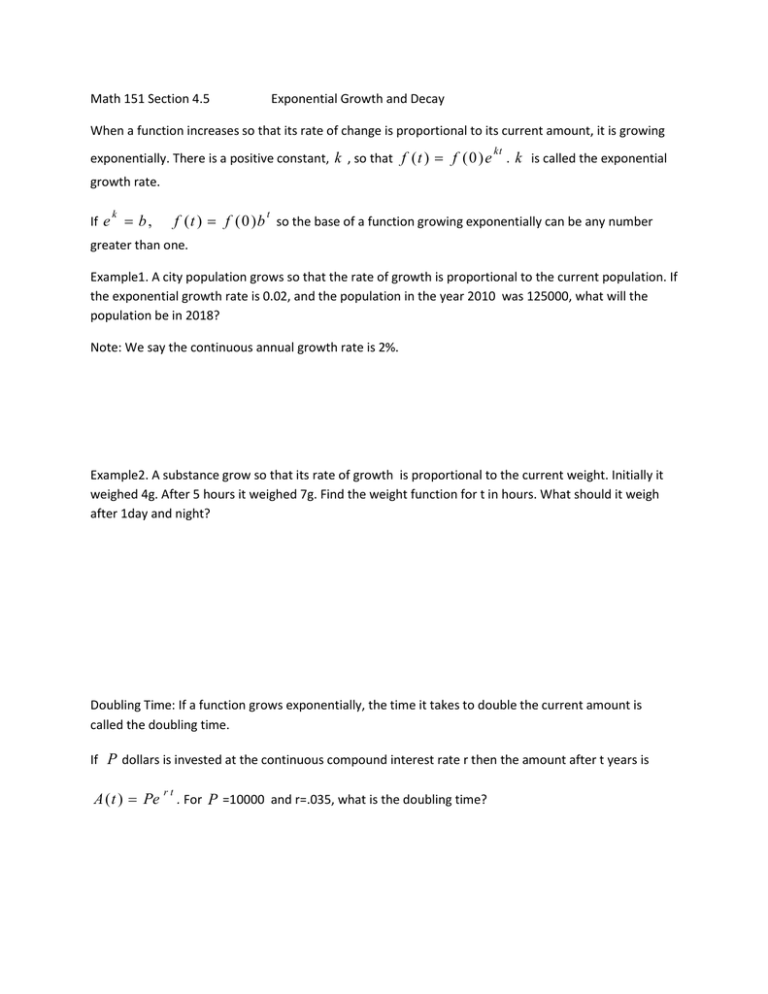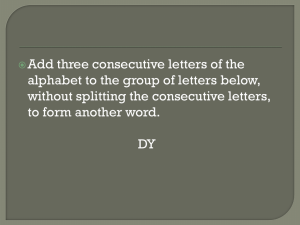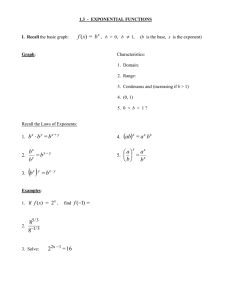Math 151 Section 4.5 Exponential Growth and Decay
advertisement

Math 151 Section 4.5 Exponential Growth and Decay When a function increases so that its rate of change is proportional to its current amount, it is growing exponentially. There is a positive constant, k , so that f ( t ) f ( 0 ) e kt . k is called the exponential growth rate. If e k b, f ( t ) f ( 0 ) b so the base of a function growing exponentially can be any number t greater than one. Example1. A city population grows so that the rate of growth is proportional to the current population. If the exponential growth rate is 0.02, and the population in the year 2010 was 125000, what will the population be in 2018? Note: We say the continuous annual growth rate is 2%. Example2. A substance grow so that its rate of growth is proportional to the current weight. Initially it weighed 4g. After 5 hours it weighed 7g. Find the weight function for t in hours. What should it weigh after 1day and night? Doubling Time: If a function grows exponentially, the time it takes to double the current amount is called the doubling time. If P dollars is invested at the continuous compound interest rate r then the amount after t years is A ( t ) Pe rt . For P =10000 and r=.035, what is the doubling time? Example 3. The weight of a substance doubles every 6 hours. Initially it weighed 10g. a) Find the weight after t days? b) What is the exponential growth rate for t in days? c) What is its rate of growth at 4 days? Example 4. A substance grows exponentially. At first it weighed 25g. After 5 days it weighed 40g. a) Find the amount after t days. b) Find the amount after 8 days. c)How fast is it growing at 8 days? Exponential decay: If a function decreases so that its rate of change is proportional to its current amount then it decays exponentially and f ( t ) f ( 0 ) e kt k is called the exponential decay rate. The half life is the time it takes to reach half the current amount. Example 5. A substance has a half life of 2560 years. How many years will it take to reach 30% of its original value? Newton’s Law of Cooling: The rate of change of the temperature of an object is proportional to the difference between its current temperature and the temperature of its surroundings. We assume the surrounding temperature is constant. If y (t ) is the temperature of the object and T is the temperature of the surroundings then y ' (t ) k ( y T ) . Since T is constant, we can say ( y T ) ' ( t ) k ( y T ) so that ( y T )( t ) ( y ( 0 ) T ) e kt and y (t ) ( y (0 ) T )e kt T Examples: 1. $20,000 is invested at 3.75% annual interest compounded continuously. In how many years will the investment be worth $30,000? 2. A drug has a half life in the body of 4 days. If 15 mg are taken, when will the amount left in the body be 5 mg? 3. Carbon 14 has a radioactive isotope with a half life of 5730 years. If today it has about 74% of what it should have had initially, how old is it? 4. A thermometer measures a room’s temperature as 20 degrees centigrade. The thermometer is taken outdoors where the temperature is 5 degrees C. After one minute, the thermometer has cooled to 12 degrees C. a) Find the temperature reading after two minutes. b) Find the time it will take for a reading of 6 degrees C.








